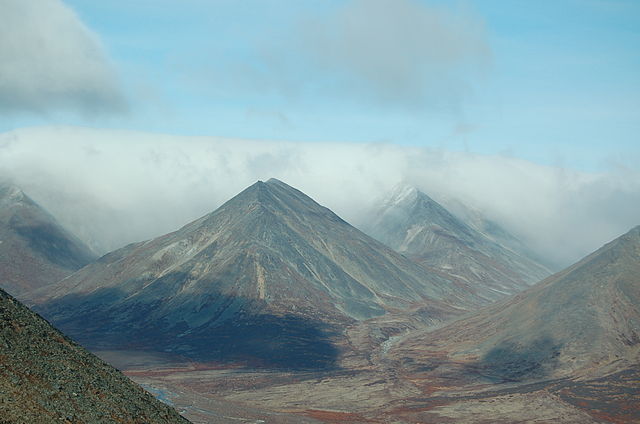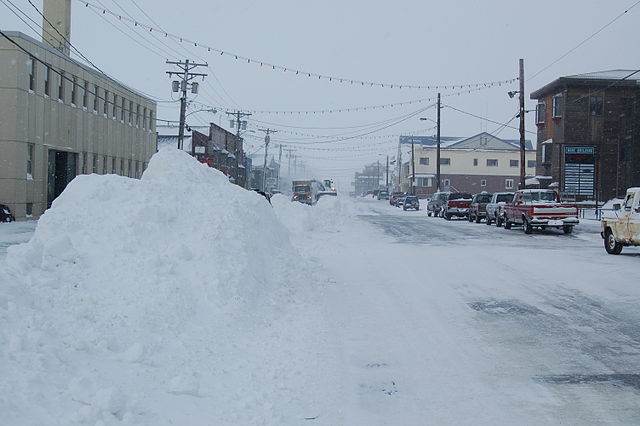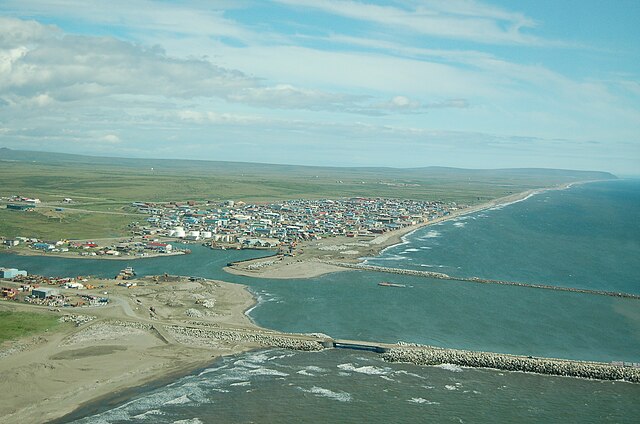Imagine a place where the sun barely sets in summer, where gold rush history whispers through the streets, and where the raw beauty of the Arctic grips your soul. That’s Nome, Alaska—a small town perched on the edge of the Bering Sea, where adventure meets history in a way that feels like stepping into a different world. Nome isn’t just a dot on the map; it’s a living testament to human resilience, a hub of cultural fusion, and a gateway to some of the most untouched landscapes on Earth. Let’s take a journey through this remote Alaskan gem and uncover why Nome deserves a spot on your travel radar.
Where Is Nome, Alaska?
Nestled on the southern coast of the Seward Peninsula, Nome sits along the shores of the Bering Sea, facing Russia’s far eastern frontier across the water. It’s about 540 miles northwest of Anchorage, but don’t expect a quick road trip—Nome is only accessible by air or sea, with no roads connecting it to the rest of Alaska. This isolation gives Nome its unique charm, like a secret hideaway you stumble upon by chance. The town’s coordinates (64.5011° N, 165.4064° W) place it just below the Arctic Circle, meaning it’s close enough to experience extreme daylight shifts but far enough to avoid the perpetual darkness of winter’s polar night.
A Glimpse at Nome’s Geography
Picture a rugged coastline with waves crashing against rocky beaches, backed by rolling tundra hills that stretch into the horizon. Nome’s landscape is stark yet breathtaking, with the Bering Sea’s icy waters shaping its identity. The town itself is compact, with a population hovering around 3,600, but its surroundings are vast—think wide-open spaces where caribou roam and the Northern Lights dance on clear winter nights. The nearby Kigluaik Mountains add a dramatic backdrop, inviting adventurers to explore their trails.
The Gold Rush Legacy
Nome’s story is inseparable from the Klondike Gold Rush of the late 1890s. Back then, word spread like wildfire that gold was literally washing up on Nome’s beaches. Prospectors flooded the area, turning a quiet Native village into a bustling hub of fortune-seekers. By 1900, Nome was Alaska’s largest city, with tents stretching along the shore and dreams of riches fueling a chaotic boomtown vibe. Ever heard of “gold fever”? Nome had it in spades.
The Famous “Three Lucky Swedes”

The spark that lit Nome’s gold rush came from three Scandinavian immigrants—Jafet Lindeberg, Erik Lindblom, and John Brynteson—known as the “Three Lucky Swedes.” In 1898, they struck gold in Anvil Creek, and the news triggered a stampede. Their discovery wasn’t just a personal win; it transformed Nome into a global headline. Today, their legacy lives on in local lore and the gold-panning opportunities that still draw visitors to Nome’s streams.
Gold Mining Today
While the frenzied days of the gold rush are long gone, mining hasn’t vanished from Nome. Small-scale operations and recreational panning keep the tradition alive. Ever watched *Bering Sea Gold* on TV? That’s Nome—dredgers still scour the seabed for flecks of gold, battling the elements for a chance at treasure. Visitors can try their hand at panning, and who knows? You might just find a nugget to call your own.
A Cultural Tapestry: Nome’s Indigenous Roots
Beneath the gold rush hype lies a deeper story—Nome is built on the ancestral lands of the Iñupiat people. For centuries, they’ve thrived in this harsh environment, hunting, fishing, and crafting traditions that endure today. Nome’s cultural heartbeat is a blend of Indigenous heritage and the diverse influences brought by miners, traders, and explorers. It’s like a quilt, each patch telling a story of resilience and adaptation.
Iñupiat Traditions and Modern Life
The Iñupiat community remains a vital part of Nome, with traditions like subsistence hunting and ivory carving passed down through generations. Events like the Nome Native Youth Olympics showcase athletic skills rooted in survival techniques, like flipping over ice floes or carrying heavy loads. Visiting Nome means you might catch a glimpse of these traditions, whether through a cultural festival or a chat with a local elder at the community center.
The Iditarod: Nome’s Claim to Fame
If you’ve heard of Nome, chances are it’s because of the Iditarod Trail Sled Dog Race. This grueling 1,000-mile race from Anchorage to Nome is the stuff of legends, with mushers and their dogs battling blizzards and subzero temperatures to reach the finish line under Nome’s iconic Burled Arch. The race, held every March, draws global attention and celebrates Alaska’s frontier spirit. Ever wonder what it takes to race across frozen wilderness? Nome’s the place to find out.
The 1925 Serum Run: A Heroic Legacy
Nome’s Iditarod fame ties back to a historic event—the 1925 Serum Run. When a diphtheria outbreak threatened the town, teams of mushers and sled dogs relayed life-saving antitoxin 674 miles from Nenana to Nome in just five and a half days. Balto, the lead dog of the final leg, became a global hero, and his statue in Nome’s town square is a must-see. This story of courage still resonates, reminding us how far people (and dogs) will go to save lives.
Nome’s Unique Climate and Natural Wonders
Nome’s weather is as wild as its history. Summers bring nearly 24 hours of daylight, with temperatures creeping into the 50s or 60s°F—perfect for hiking or fishing. Winters, though, are another beast, with temperatures plunging below zero and the Bering Sea freezing over. The polar night doesn’t fully envelop Nome, but you’ll still experience long, starry nights perfect for aurora hunting. Ever seen the sky light up like a cosmic painting? Nome’s one of the best places for it.
Wildlife and Outdoor Adventures
Nome’s surroundings are a playground for nature lovers. The Bering Land Bridge National Preserve, just north of town, is a remnant of the ancient land bridge that once connected Asia and North America. Here, you might spot muskoxen, grizzly bears, or migratory birds. Fishing for salmon or Arctic char is a local favorite, and the Nome-Council Highway offers scenic drives past tundra landscapes. Whether you’re kayaking along the coast or snowmobiling in winter, Nome’s outdoors will leave you awestruck.
Modern Nome: A Community with Heart

Today’s Nome is a tight-knit community that balances its rugged past with modern life. The town has all the essentials—schools, a hospital, a grocery store—but it’s the people who make it special. Locals are quick to share a story or offer a warm smile, making visitors feel like they belong. It’s like stepping into a small-town movie, but with Arctic flair.
Local Businesses and Economy
Nome’s economy leans on fishing, tourism, and government services, with gold mining still playing a role. Small businesses, like the Bering Sea Bar & Grill or the Nome Nugget Inn, give the town its character. The *Nome Nugget*, Alaska’s oldest newspaper, keeps residents connected with local news. Shopping here means supporting family-owned stores, and you’ll find everything from Native crafts to practical gear for Arctic adventures.
Visiting Nome: What to Expect
Planning a trip to Nome? Prepare for an adventure unlike any other. Flights from Anchorage or Fairbanks are the easiest way to get here, with daily services on regional airlines like Bering Air. Once you land, rent a car or bike to explore—the town’s compact size makes it easy to navigate. Accommodations range from cozy B&Bs to hotels like the Aurora Inn, but book early, especially during Iditarod season. What’s the vibe like? Think laid-back, friendly, and a little quirky.
Top Attractions in Nome
Nome’s attractions are a mix of history, culture, and nature. The Carrie M. McLain Memorial Museum dives into the town’s gold rush and Iñupiat history, with artifacts like old mining tools and Native carvings. The Swanberg Dredge, a massive relic from the gold rush, is a photographer’s dream. Don’t miss the chance to pan for gold at local creeks or visit the Safety Roadhouse, a historic stop along the Iditarod trail. And if you’re lucky, you might catch a glimpse of the Northern Lights from Front Street.
Festivals and Events
Nome’s calendar is packed with events that bring the community together. The Iditarod finish is the big one, with festivities spilling into bars and streets. The Midnight Sun Festival in June celebrates the endless summer daylight with music, food, and gold-panning contests. For a taste of Iñupiat culture, the Bering Sea Arts Festival showcases traditional crafts and performances. These events aren’t just fun—they’re a window into Nome’s soul.
Challenges of Life in Nome
Living in Nome isn’t for the faint of heart. The isolation means groceries and supplies come at a premium, often flown in from Anchorage. Harsh winters test resilience, and the lack of road access can feel like living on an island. Yet, locals embrace these challenges, finding joy in the simplicity and beauty of their surroundings. It’s like choosing to live in a place where nature calls the shots, and you’re just along for the ride.
Connectivity and Infrastructure
Despite its remoteness, Nome stays connected with reliable internet and cell service, though don’t expect lightning-fast speeds. The Nome Airport handles daily flights, and the port welcomes cruise ships in summer. Schools and healthcare facilities serve the community well, but specialized care often requires a trip to Anchorage. It’s a balance—modern amenities meet frontier life, creating a unique rhythm.
Why Nome Matters Today

Nome isn’t just a relic of the past; it’s a vibrant community that embodies Alaska’s spirit. Its history of gold, grit, and heroism continues to inspire, while its natural beauty and cultural richness make it a destination for those seeking something real. In a world of cookie-cutter travel spots, Nome stands out as a place where you can feel the pulse of history and the power of nature in every moment.
Planning Your Nome Adventure
Ready to visit Nome? Pack for the season—layers for summer, heavy gear for winter. Bring a sense of curiosity and a willingness to embrace the unexpected. Whether you’re chasing the Northern Lights, panning for gold, or cheering on Iditarod mushers, Nome will leave you with stories to tell. It’s not just a trip; it’s a journey into a world where history, culture, and wilderness collide.
Conclusion
Nome, Alaska, is more than a remote town on the Bering Sea—it’s a place where history comes alive, where nature humbles you, and where community feels like family. From its gold rush roots to its role as the Iditarod’s finish line, Nome weaves a story of adventure and resilience that captivates anyone who visits. Whether you’re drawn by the call of the wild, the thrill of history, or the warmth of its people, Nome delivers an experience that’s as unforgettable as it is unique. So, what are you waiting for? Start planning your trip to this Arctic gem and discover why Nome is a treasure worth finding.
Frequently Asked Questions
1. How do I get to Nome, Alaska?
Nome is accessible by air from Anchorage or Fairbanks via regional airlines like Bering Air or Alaska Airlines. You can also arrive by cruise ship in summer or by snowmachine or dog sled in winter, though those are less common. There are no roads connecting Nome to other parts of Alaska.
2. What’s the best time to visit Nome?
Summer (June to August) offers mild weather and nearly 24-hour daylight, perfect for outdoor activities. Winter (March) is ideal for the Iditarod or Northern Lights viewing, but be prepared for cold temperatures and limited daylight.
3. Can I pan for gold in Nome?
Absolutely! Visitors can pan for gold at local creeks or join guided tours. Some businesses offer gold-panning experiences, and you might even find small nuggets to keep as souvenirs.
4. What wildlife can I see in Nome?
Nome’s region is home to muskoxen, grizzly bears, caribou, and migratory birds. The Bering Sea also hosts seals, walruses, and whales. Guided tours or visits to the Bering Land Bridge National Preserve are great ways to spot wildlife.
5. Is Nome safe for tourists?
Nome is generally safe, with a friendly, small-town vibe. However, its remote location and extreme weather require preparation. Follow local advice, dress for the conditions, and be aware of wildlife when exploring the outdoors.

